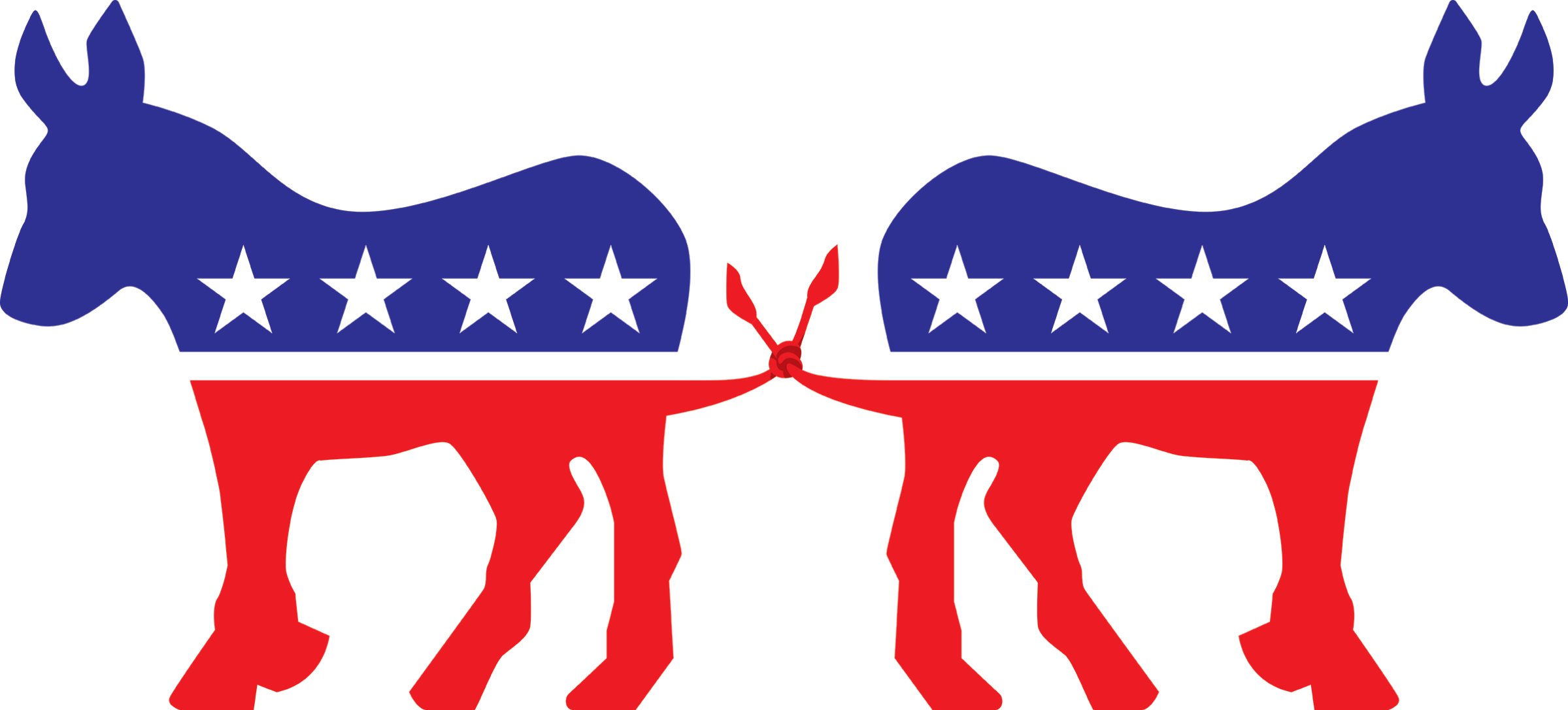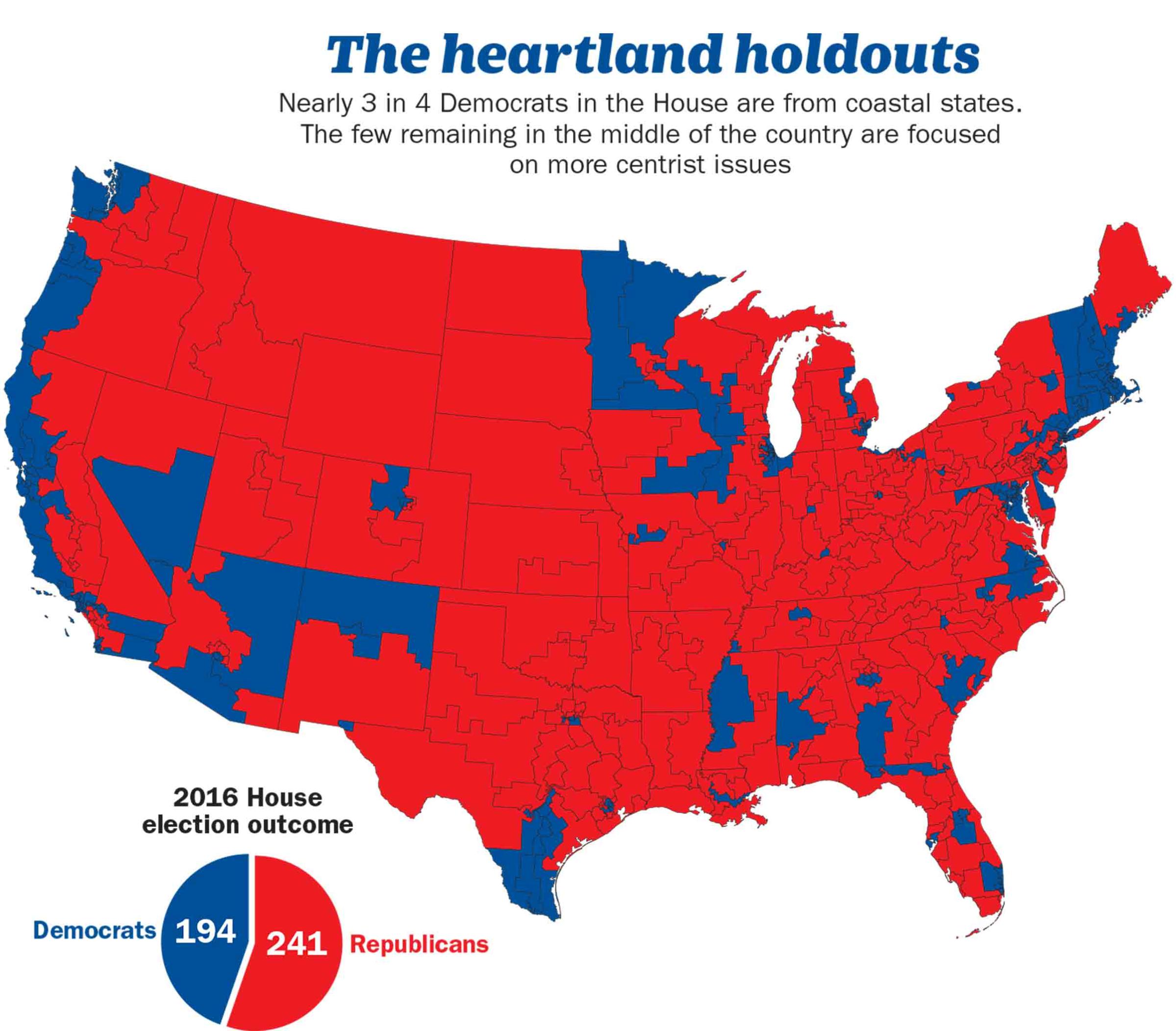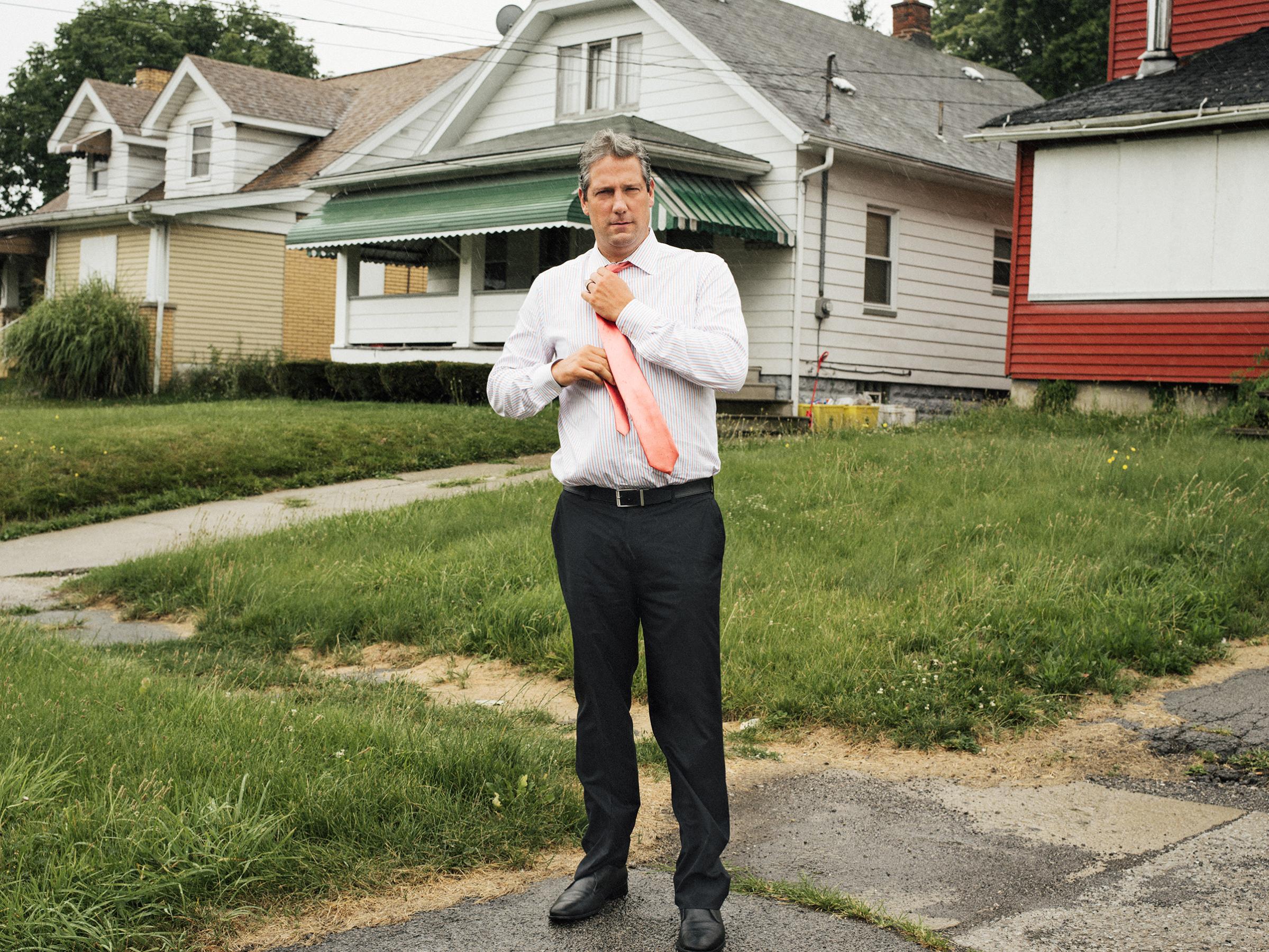
Like virtually all Democrats, Tim Ryan is no fan of Donald Trump. But as he speeds through his northeastern Ohio district in a silver Chevy Suburban, the eight-term Congressman sounds almost as frustrated with his own party. Popping fistfuls of almonds in the backseat, Ryan gripes about its fixation on divisive issues and its “demonization” of business owners. Ryan, 44, was briefly considered for the role of Hillary Clinton’s running mate last year. Now he sounds ready to brawl with his political kin. “We’re going to have a fight,” Ryan says. “There’s no question about it.”
That fight has already begun, though you’d be forgiven for missing it. On the surface, the Democratic Party has been united and energized by its shared disgust for Trump. But dig an inch deeper and it’s clear that the party is divided, split on issues including free trade, health care, foreign affairs and Wall Street. They even disagree over the political wisdom of doing deals with Trump.
Every party cast out of power endures a period of soul-searching. But the Democrats’ dilemma was unimaginable even a year ago, when Clinton seemed to be coasting toward the White House and demographic change fueled dreams of a permanent national majority. Now, eight months into the Trump presidency, the party looks to face its toughest odds since Ronald Reagan won 49 states in 1984. The Democrats are in their deepest congressional rut since the class of 1946 was elected, and hold the fewest governors’ mansions–15–since 1922. Of the 98 partisan legislatures in the U.S., Republicans control 67. During Barack Obama’s presidency, Democrats lost 970 seats in state legislatures, leaving the party’s bench almost bare. The median age of their congressional leadership is 67, and many of the obvious early presidential front runners will be in their 70s by the 2020 election.
Meanwhile, there’s still no sign the Democrats have learned the lessons of the last one. “I’ve tried to learn from my own mistakes. There are plenty,” Clinton writes in her campaign memoir What Happened. The book, released on Sept. 12, casts blame on Russia, the FBI and the candidate herself, but never quite finds a satisfying answer to the titular question. Even if it did, these days the party seems to prize ideological purity over Clintonian pragmatism. “There is no confusion about what we Democrats are against. The only disagreement,” says strategist Neil Sroka, “is what we’re for.”
Which leaves the party confronting a puzzle. The momentum may be on the left, but picking up the 24 seats required to retake the House, and the three states needed for control of the Senate, will mean luring back blue collar workers in places like Ryan’s Mahoning Valley district, where the steel plants are shells of their former selves, small businesses are boarded up and payday lenders seem to be on every corner. This used to be a Democratic stronghold, but Trump won three of the five counties in Ryan’s district. If Democrats don’t refine their pitch to alienated white voters, Trump could win re-election with ease. “The resistance can only be part of it,” Ryan says. “We have to be on the offense too.”
It’s not clear who has the influence or inclination to spearhead that shift. Senate minority leader Chuck Schumer and House minority leader Nancy Pelosi are seasoned dealmakers who can raise Brink’s trucks full of cash. Their Sept. 6 pact with Trump, which pushed back a pair of fiscal showdowns and delivered hurricane relief money to storm-stricken southeastern Texas, was hailed as a fleecing by the Democrats. After a dinner of Chinese food in the Blue Room of the White House a week later, the pair said they had reached a tentative agreement with Trump to sidestep the Justice Department’s rollback of an Obama-era program that helped young immigrants who were in the country illegally. But among the grassroots, any agreement with the President is viewed as cause for suspicion. When Schumer dared to back a handful of Trump’s Cabinet picks earlier this year, activists protested outside his Brooklyn apartment, hoisting signs with slogans like Grow a spine, Chuck. In her San Francisco district on Sept. 18, Pelosi was shouted down by activists who were angry that her proposed immigration deal with Trump did not cover more people.

For all these challenges, the party’s time in the wilderness could prove to be an opportunity. A poll from CNN/SSRS in August showed Democrats with an 11-percentage-point advantage over Republicans on a generic congressional ballot. “Winning is the first goal of governing,” says Chicago Mayor Rahm Emanuel, a former head of the Democratic Congressional Campaign Committee. “You can’t have a governing part without a winning part.” But before the party comes together, first it has to banish the furies that threaten to tear it apart.
The counterpoint to Ryan’s call for moderation could be found onstage in August in a Hyatt ballroom in Atlanta. Senator Elizabeth Warren, the former Harvard Law School professor and consumer advocate, had come to deliver a battle cry to 1,000 grassroots activists. “The Democratic Party isn’t going back to the days of welfare reform and the crime bill,” she said in not-at-all-veiled criticism of President Bill Clinton’s mid-’90s strategy to peel off Republican votes. “We are not a wing of today’s Democratic Party,” Warren declared to her fellow liberals. “We are the heart and soul of today’s Democratic Party.”
Warren is clearly thinking of running for President in 2020. If she does, a crowd will be waiting to cheer her on: a year ago, under pressure from supporters of insurgent Senator Bernie Sanders, the Democrats adopted the most progressive platform in their history, which called for free college for families earning $125,000 or less and Medicare options for Americans as young as 55. This march to the left has become a sprint since Clinton’s defeat.
Groups that support abortion rights have stopped offering polite silence to Democrats who disagree. Others are demanding jail time for bank executives. Small-dollar donors are goading progressive groups to advance liberal policies and challenge lawmakers who balk. A group of prominent liberal Democrats, including some 2020 hopefuls, are pushing a national single-payer health care plan–even though its strongest backers acknowledge that it has zero chance of becoming law in this Republican-controlled Congress. Representative Luis Gutiérrez of Illinois threatened on Sept. 8 that Democrats may shut down the government in December if Congress doesn’t provide a pathway for undocumented immigrants to become citizens. “Running on progressive values,” strategist Adam Green told a candidates’ training session in Washington this summer, “is how Democrats will win.”
History counters this, at least at the presidential level. The most progressive nominees in recent memory–Michael Dukakis in 1988, Walter Mondale in 1984 and George McGovern in 1972–all suffered landslide defeats. But this liberal vision is most popular among the younger ranks of Democrats. A survey in July of young voters likely to participate in primaries spells out where the Democrats are headed: 43% of 18-to-29-year-olds said they were more liberal than the party, while 20% described the party as “conservative.”
Efforts to mend the rifts of the 2016 election have fallen flat. Earlier this year, the Democratic National Committee (DNC) launched a national tour with Sanders and newly minted party chairman Tom Perez, who was elected in February. Things didn’t go well. When Sanders thanked Perez at rallies, his so-called Bernie bros heckled the new chairman. The attempt at unity was a footnote within a month. “The current model and the current strategy of the Democratic Party is an absolute failure,” declared Sanders, who plans to seek a third term in the Senate next year as an independent.
Activists aligned with Sanders are working to mount primary challenges against centrist Democrats. Our Revolution, a group that rose from the ashes of Sanders’ presidential campaign, led a protest in August outside the DNC, demanding a more liberal platform. Party staffers tried handing out snacks and bottles of water, but the hospitality did little to defuse the tension. “They tried to seduce us with doughnuts,” said former Ohio state senator Nina Turner, a protest organizer.
Some of the grievances hinge on strategy as much as substance. Kamala Harris, the popular junior Senator from California, backs Sanders’ health plan and won an endorsement from Warren during her election last year. But as California’s former top cop, Harris declined to prosecute bankers, including Treasury Secretary Steve Mnuchin, for their role in the 2008 financial crisis. She also spent part of her summer raising cash in the tony precincts of the Hamptons. As a result, Sanders allies say she’s a Wall Street shill. “Follow the money,” says Nomiki Konst, a Sanders supporter who serves on the DNC panel tasked with forging postelection unity.
No one waits on the horizon to broker a peace. The DNC has been hollowed out, first by Obama’s neglect and then by a Clinton campaign that raided its talent. Now it is trying to play catch-up, sending $10,000 a month to each state party to help add bodies and channel activists’ energy into permanent organizations. But the party is still $3.5 million in the red, and Republicans are outraising it by a margin of roughly 2 to 1. Meanwhile, Perez is serving as a visiting fellow at Brown University, where he teaches a course called Governance and Leadership in Challenging Times.

Schumer says the party lost the White House in 2016 because it had a “namby-pamby” message on the economy. He’s not risking that again, working with members from both chambers on an aggressive, worker-focused message. The blueprint, dubbed “A Better Deal,” has Warren’s fingerprints all over it, calling for a national $15-per-hour minimum wage and cheaper drugs, colleges and child care. “The focus starts on economic issues,” Schumer said. “That’s where the American people are hurting.”
Ignoring that struggle has caused headaches in the heartland. Today only 28% of House Democrats hail from states that don’t touch the Atlantic or Pacific oceans, down from 37% in 2007. The survivors have tried to distance themselves from the party’s leftward drift. “When I’m back home, I’m not talking party issues,” says Representative Ron Kind, an 11-term Democrat from La Crosse, Wis., whose Capitol Hill office features pictures of him hunting. “I’m not on the stump bashing Republicans.”
This breed of Democrat is endangered but hardly extinct. Dave Loebsack, who represents a district in eastern Iowa, spent his August break from Washington meeting with rural farmers. John Yarmuth, the lone Democrat in Congress from Kentucky, focuses on his work to preserve Obamacare, which provides health care coverage to almost 500,000 low- and middle-income residents in his state. Cheri Bustos represents parts of northwestern Illinois, where she gamely pivots away from divisive issues like guns to local workers’ families and business prospects at John Deere and Caterpillar, which both have big footprints in her district.
Governing in Washington these days is “the most frustrating thing I’ve ever done,” complains Senator Joe Manchin, a West Virginia Democrat. “Most of my life, there was about 20% on the right fringe and the left fringe, but 60% in the middle, where common sense would prevail. Now I’m thinking 40% on each fringe.”
Part of the problem is that red states are getting redder, while blue states are growing ever more blue. Consider West Virginia, where Manchin is still popular from his days as governor. When Bill Clinton ran for President in 1992, he carried 42 of the state’s 55 counties. That number climbed to 43 four years later. But by 2000, West Virginia residents were sour on Democratic trade policies that many saw as costing them coal and steel jobs. Al Gore won 13 counties that year, and John Kerry took just nine in 2004. It’s little wonder that during Manchin’s first campaign for Senate, in 2010, he cut an ad that showed him firing a rifle at an Obama-backed environmental bill. Obama would go on to lose all 55 counties in 2012–a feat Hillary Clinton repeated.
Democrats still outnumber Republicans in West Virginia by 12 percentage points. These Democrats, however, don’t want to hear about NFL players protesting during the national anthem or the latest in the ongoing investigation into Trump’s alleged ties to Moscow. They care far less about Black Lives Matter than keeping their checking accounts in the black. Add in the 21% of West Virginians who say they don’t identify with either party, and it’s a dangerous proposition for candidates like Manchin to parrot talking points from MSNBC. It’s not that he’s a squish on cultural issues; it’s that he’d rather talk about lifting the economy in his state, where 18% live in poverty.
The Democrats’ focus on identity politics is one reason Manchin suggested, half-heartedly, that he doesn’t care if he wins another term next year. “The Washington Democrats’ mentality has been more urban,” he says. “They forgot about rural America and rural states. They don’t want you to tell them about their bathrooms or their bedrooms or all this other stuff we’re trying to control.”
Some say another problem is Pelosi. The first female House speaker and a legendary vote wrangler, she was widely, if wrongly, blamed for a series of special-election defeats in the spring, even though Democrats fared far better than usual in places like Kansas and Georgia. A special election in June became less about the candidates than about the specter of Pelosi, whom Republicans cast as a puppet mistress for the Democratic nominee. “A lot of the demonization directed toward her,” says Kind, “is patently unfair. But that’s been the perception that’s been created.” Ryan’s long-shot bid to replace her as House Democratic leader won 63 votes last year.

Part of Ryan’s pitch has been to put away the pitchforks and modulate the tone. “We cannot be a party that is hostile to business. We need those businesspeople to hire our people, who just want a shot,” Ryan fumes. “We can be business-friendly and still be progressive.” And while it puts him at odds with some peers, such arguments have also won him some unlikely fans. “The smart guys in the Democratic Party, they understand what’s going on. [Ohio Democratic Senator] Sherrod Brown gets this. Tim Ryan gets this,” Trump’s former chief strategist Stephen Bannon told 60 Minutes’ Charlie Rose in an interview that aired on Sept. 10. “The only question before us: Is it going to be a left-wing populism or a right-wing populism?”
One Democrat who has found a happy middle ground is Ryan’s colleague Brown, who is campaigning for his third term in 2018. He’s tough on trade but hardly a protectionist, as progressive as Warren but willing to work with fellow Ohioan Rob Portman, a Republican Senator, to write legislation to address their state’s opioid crisis. Brown recognizes that the shifts influencing his colleagues can change from state to state. “Demographics are not changing dramatically in Ohio. They are changing in Colorado and Virginia and Arizona and Nevada and North Carolina,” Brown says, “and making those states more Democratic.”
Ohio is experiencing a different kind of upheaval. In Mahoning County, home to Youngstown, Hillary Clinton won just shy of 50% of the vote; Obama carried 63% four years earlier. In Trumbull County next door, where Ryan lives, Trump became the first Republican to win since 1972. Overall, Trump won 44% of the vote in Ryan’s district, four years after Mitt Romney captured just 36%. “Our members didn’t know better, unfortunately, and they did vote for him,” says Tony DiTommaso Jr., secretary-treasurer of Western Reserve Building Trades, a coordinating body for 7,500 unionized workers in northeastern Ohio. “They wanted a change. They didn’t care what it was.”
One only needs to look at the shuttered mom-and-pop businesses dotting Ryan’s district to see why voters were inclined to listen to Trump’s promises. Which is why Ryan is pushing plans to bring high-speed Internet to the farming communities and to recruit tech giants to the cheap real estate in local cities and towns.
On a Friday in late July, Ryan was padding through the Basilica of Our Lady of Mount Carmel’s annual Italian festival in Youngstown. Simmering red sauce was heaped on polenta, and elephant ears layered with powdered sugar were matched with mostaccioli showered with ground Parmesan from plastic tubes. It was a throwback to a time when church socials defined communities. “These are my peeps,” Ryan says to no one in particular as voters swarm him. “He doesn’t forget where he came from,” says Robert Rodkey, 71, after saying hello to Ryan. “Union isn’t a word for him. It’s a way of life. Now if only the Democrats would follow him.”
If Ryan has bigger ambitions to lead, he is not alone. A shadow campaign for the 2020 nomination is quietly taking shape in early-nominating states like Iowa and New Hampshire. Some of the most interesting names are unfamiliar ones. Senator Jeff Merkley of Oregon and Pete Buttigieg, the mayor of South Bend, Ind., visited Iowa in early September to check in. Jason Kander, the former Missouri secretary of state who is viewed as a rising party star, recruited a Sanders aide to stake out territory in Iowa and has announced plans to open offices for his voting-rights group in five states. The Iowa steak fry, previously led by former Senator Tom Harkin, is an annual rite of passage for Democratic presidential hopefuls and will draw Ryan, Bustos and Representative Seth Moulton of Massachusetts in September.
“We have the next generation of Democratic leaders. We need to lift them up in the public eye,” says Stephanie Schriock, president of Emily’s List, a group dedicated to electing women who support abortion rights. “This is not a party of one leader. It’s just not.”
Back in Youngstown, you can see the wheels spinning in Ryan’s head. He sees a role for a Midwesterner who can connect with the working-class voters who took comfort in Trump’s rage. Indeed, he thinks the Democrats’ future depends on it. “We can get the party back on track,” Ryan says as his SUV rolls away from a meeting with Ohio union chiefs. “Someone’s going to figure this out. Someone needs to.”
More Must-Reads From TIME
- The 100 Most Influential People of 2024
- Coco Gauff Is Playing for Herself Now
- Scenes From Pro-Palestinian Encampments Across U.S. Universities
- 6 Compliments That Land Every Time
- If You're Dating Right Now , You're Brave: Column
- The AI That Could Heal a Divided Internet
- Fallout Is a Brilliant Model for the Future of Video Game Adaptations
- Want Weekly Recs on What to Watch, Read, and More? Sign Up for Worth Your Time
Write to Philip Elliott / Youngstown, Ohio at philip.elliott@time.com